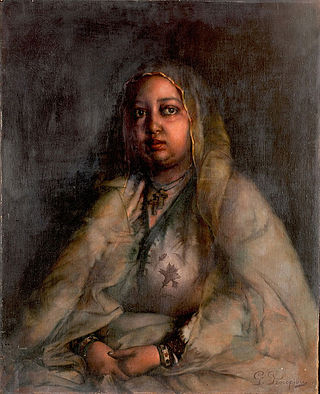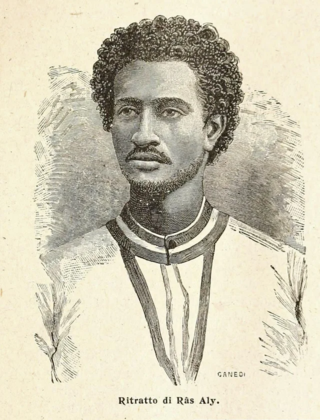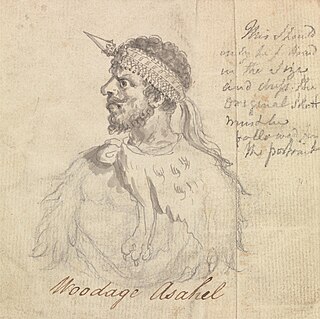
Taytu Betul was Empress of Ethiopia from 1889 to 1913 and the third wife of Emperor Menelik II. An influential figure in the anti-colonial resistance during the late 19th-century Scramble for Africa, she, along with her husband, founded the modern Ethiopian capital Addis Ababa in 1886.
Gigar was Emperor of Ethiopia intermittently between 1821 and 1830, and purportedly a member of the Solomonic dynasty.
Marye of Yejju was a Ras of Begemder and Enderase (regent) of the Emperor of Ethiopia. He was the brother of his predecessor Ras Yimam.
Dori of Yejju was a Ras of Begemder and Inderase (regent) of the Emperor of Ethiopia. He was the brother of his predecessor Marye of Yejju.
Yimam of Yejju was a Ras of Begemder and Enderase (regent) of the Emperor of Ethiopia. He was the son of Gugsa of Yejju.
Ali I of Yejju was Ras of Begemder, and following the death of Ras Mikael Sehul, Regent of the Emperor of Ethiopia. He was the son of Abba Seru Gwangul, chieftain of the Yejju, and Woizero Gelebu Faris, daughter of Ras Faris of Lasta.

Ali II of Yejju was Ras of Begemder and the de facto ruler of the Ethiopian Empire. He was a member of a powerful Welo dynasty known as the Yejju, which ruled much of the Ethiopian Empire during the Zemene Mesafint.

Sabagadis Woldu was a governor of Tigray Province of the Ethiopian Empire from 1822 to 1831. Sabagadis gained some notoriety in the first decade of the 19th century for rebelling a number of times against his overlord, Ras Wolde Selassie. But just before the death of Wolde Selassie it seems that he made up with his master and became one of his loyal lieutenants. Following Wolde Selassie's death in 1816, he defied the authority of Wolde Selassie's son, and became the most powerful warlord in Tigray. Making Adigrat his capital, he ruled Tigray and the coastal plains of Eritrea by 1818. His rule also extended to the Eritrean highlands.
The Battle of Debre Tabor was a conflict during the Zemene Mesafint in 1842 initiated by Dejazmach Wube Haile Maryam to overthrow Ras Ali II as Regent of the Emperor of Ethiopia and gain control of Ethiopia. This confused battle was won by Ras Ali, but at a steep price, and this victory failed to cement his position as the most powerful nobleman of his time.

The Zemene Mesafint was a period in Ethiopian history between the mid-18th and mid-19th centuries when the country was ruled by a class of Oromo elite noblemen who replaced Habesha nobility in their courts, making the emperor merely a figurehead. For the most part, the regional lords were tightly related by marriage and constituted a stable ruling elite that prevailed until the mid-20th century. In short, during the Zemene Mesafint, the emperors from the Solomonic dynasty were reduced to little more than figureheads confined to the capital city of Gondar.

The Yejju Oromo, also historically known as the Yajju, Edjow or Edjou Galla, are a sub-clan of the Barento branch of Oromo people. They are one of the northernmost communities of Oromo people residing in Ethiopia, along with the Raayyaa.

Semien Province was a historical province of northwest Ethiopia. According to Manoel De Almeida Semien was bordered on the north-east and north by Tigray and Tselemt, on the east and south by Abergele, and on the west by Wegera. Alexander Murray include Wag as part of Semien.
Dejazmach Birru Aligaz was a nobleman of 19th century Ethiopia during the Zemene Mesafint. As Dejazmach, he held the governorships of different districts such as Lasta and Dembiya and was made governor of Dawunt, Wollo in 1842 by Ras Ali II of Yejju. He was the son of Ras Aligaz Abba Seru Gwangul, and had a son called Dejazmach Zegeye.

Wube Haile Maryam of Semien,, also called by his title Dejazmach Wube, Webé; his name is also given in European sources as ‘‘Ubie’’, was one of the major figures of 19th century Ethiopia, during the closing decades of the Zemene Mesafint a period of regional lords vying for power, prestige and territory amid a weakened authority of the emperors.
Haile Maryam Gebre of Semien, Horse name: Abba Dammana was an early 19th century governor of Semien, Welkait and Wogera. Haile Maryam tried to hold his hereditary possessions in the face of continuous pressure from rival lords during Ethiopia's Zemene Mesafint era. He is remembered as the guardian of Waldeba monastery.
Gebre Tasfa better known as Gebre of Semien was the governor of Semien, Tsegede, Welkait and Wogera during the late 18th and early 19th century in Ethiopia. He held the title of Ras, and had an unusually long reign spanning 44 years during the tumultuous Zemene Mesafint when lords of each province and district continuously fought each other for supremacy. Ras Gebre was the primary backer of his son-in-law Emperor Tekle Giyorgis I claims to the throne.

Welde Giyorgis Aboye was one of the most prominent Ethiopian generals who spearheaded Emperor Menelik's southward expansion at the close of the 19th century. His fame soared after leading the conquest on the Kingdom of Kaffa as a Ras, and was subsequently appointed as provincial governor of that fief by the Emperor. Welde Giyorgis later became the governor of Begemder. A few months before his death, he was elevated to Negus, of Gondar by Empress Zewditu in 1917, as recognition for his role in deposing Lij Iyasu.
Betul Haile Maryam was a member of the Semien nobility through his paternal line in the Ethiopian Empire.
Goshu Zewde of Gojjam, also known by his horse name Abba Kanno, was a prominent governor of Damot, Metcha, and Ybaba during the first half of the 19th century. While his son Birru Goshu governed most of Gojjam, Goshu’s influence extended widely, solidifying his reputation as a formidable leader. As a member of the ruling dynasty of Gojjam, he was one of the significant lords in the last decades of the Zemene Mesafint. Respected by princes, church leaders, and farmers alike, Goshu was admired for his noble lineage and his admirable character. His influence and dedication were further recognized when he was granted the title of Dejazmach in 1825 and elevated to Ras by Emperor Sahle Dengel in 1848.
Welle Betul also known as Wale Betul, Wolie Betul and Wele Bitul, was an Ethiopian military commander under Emperor Menelik II, the ruler of Begemder, and the younger brother of Empress Taytu Betul.







